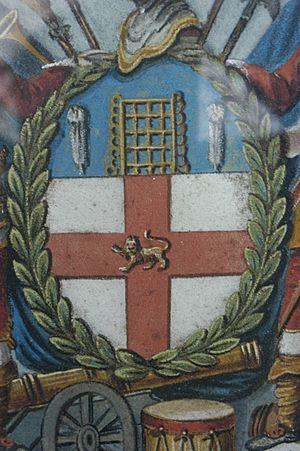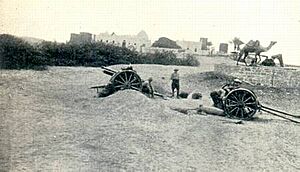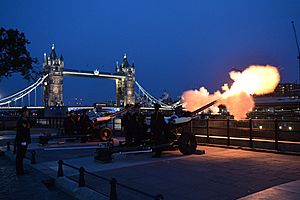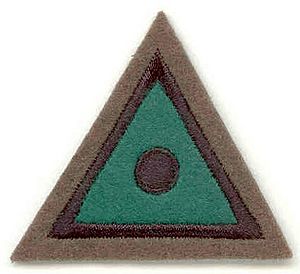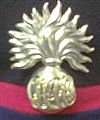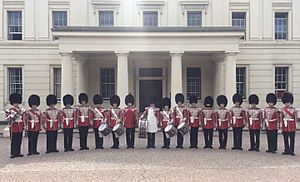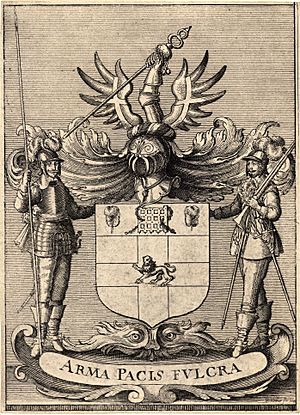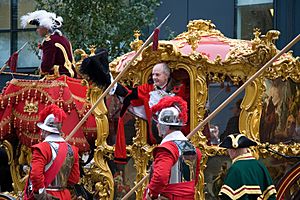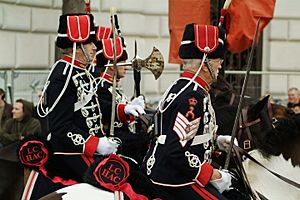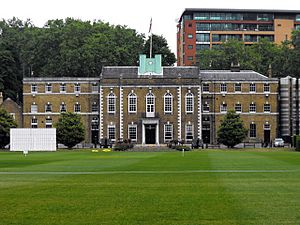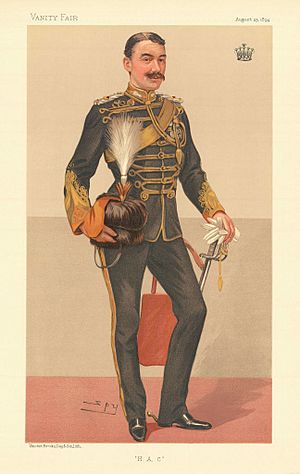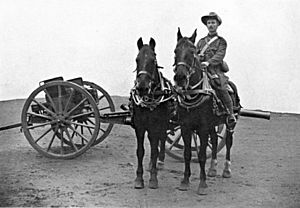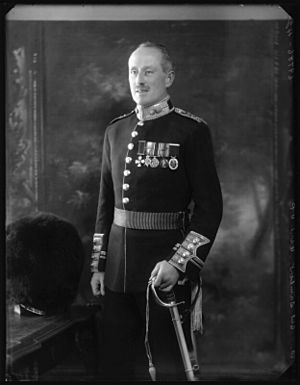Honourable Artillery Company facts for kids
Quick facts for kids Honourable Artillery Company |
|
|---|---|
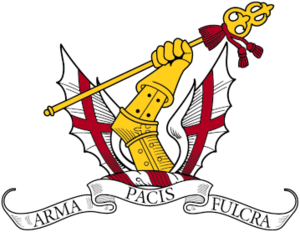
Crest and motto of the Honourable Artillery Company
|
|
| Active | 1087; chartered 25 August 1537– |
| Allegiance | |
| Branch | |
| Role | surveillance and target acquisition (STA) parachute artillery |
| Size | One regiment 470 personnel |
| Part of | 77th Brigade |
| Garrison/HQ | London |
| Motto(s) | Arma pacis fulcra (Latin: "Armed Strength for Peace") |
| March | Quick – The British Grenadiers Slow – The Duke of York Canter – Bonnie Dundee Trot – The Keel Row Walk – The Duchess of Kent |
| Commanders | |
| Captain-General | The King |
| Colonel of the Regiment |
General Patrick Sanders KCB, CBE, DSO |
| Notable commanders |
Lt. Col. Sir Edward Heath KG, MBE General Sir Richard O'Connor KT, GCB, DSO*, MC |
| Insignia | |
| Tactical Recognition Flash |  Only worn by Corps of Drums |
| Plume | None Bearskin cap |
| Abbreviation | HAC |
The Honourable Artillery Company (HAC) is a special reserve regiment in the British Army. It was officially started by King Henry VIII in 1537. This makes it the oldest regiment in the British Army. It's also thought to be the second-oldest military group in the world!
Today, the HAC is also a charity. Its main goal is to help defend the country. It does this by supporting the HAC regiment and a group of special police officers in London. The word "artillery" in its name might sound confusing. Back when it started, "artillery" meant any kind of weapon that shot something, like arrows from a bow. So, it was more like an "Honourable Military Company" in today's language.
In the 1600s, members of the HAC helped create two famous military groups: the Royal Marines and the Grenadier Guards. More recently, parts of the company fought bravely in both World Wars. The current regiment is part of the Army Reserve. It is the oldest surviving regiment in the British Army. Most members are young people who work in and around Greater London. When they leave the active units, they can become Veteran Members and stay connected to the company.
Contents
- History of the HAC
- What the HAC Does Today
- HAC in Recent Operations
- HAC Museum
- HAC Uniforms and Symbols
- Battle Honours
- Colours
- City of London Police Special Constabulary
- The Company
- HAC Grounds
- Notable Members of the HAC
- Affiliations
- See also
- Order of precedence
History of the HAC
How the HAC Began
The HAC's history goes back to 1087. But it officially began on 25 August 1537. That's when King Henry VIII gave it a special document called a royal charter. This charter allowed a group called the Overseers of the Fraternity or Guild of St George to form a permanent group. Their job was to defend the country. They were first called the Fraternity or Guild of Artillery of Longbows, Crossbows and Handgonnes.
Over time, the group had different names. In 1658, it was first called the Artillery Company. In 1685, it was first called the Honourable Artillery Company. Queen Victoria officially gave it this name in 1860.
The HAC has a unique history. It fought on both sides during the English Civil War (1642 to 1649). This war was between the Parliament and the Royalists (supporters of the King).
The company first trained at a place called the Old Artillery Ground in Spitalfields. In 1622, they built their first Armoury House there. In 1638, they got land at their current location near Bunhill Fields Burial Ground on City Road. This new area was about 12 acres.
Forming Other Famous Units
In 1656, the Grenadier Guards were formed. Many of their first members came from the Honourable Artillery Company. These gentlemen had helped keep Prince Charles (who later became King Charles II) safe in Europe during the English Civil War.
On 28 October 1664, the group that would become the Royal Marines was first formed. They started with 1,200 soldiers from the London Trained Bands. These soldiers were trained by the Honourable Artillery Company.
Later History and Changes
In 1780, the Company helped stop the Gordon Riots in London. The City of London was so thankful that they gave the HAC "two brass field-pieces" (small cannons). This led to the creation of an HAC Artillery Division. You can still see these guns at Armoury House today.
In 1860, the government changed who was in charge of the Company. It moved from the Home Office to the War Office. In 1883, Queen Victoria said that the HAC should be ranked right after the regular army. This was because of its very old history.
Serving in South Africa
Members of the HAC fought overseas for the first time as a group in the South African War (1899–1902). About 200 members served. Most of them were part of the City of London Imperial Volunteers. They served as infantry (foot soldiers) and mounted infantry (soldiers on horseback).
Becoming Part of the Territorial Force
In 1907, the HAC became part of the new Territorial Force. This happened when the Territorial and Reserve Forces Act was passed. The HAC managed to keep its own name and identity. Its property and special rights were also protected by a law in 1908.
The First World War (1914-1918)
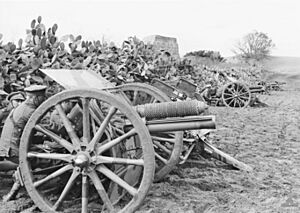
During the First World War, the HAC grew a lot. It had three infantry battalions (large groups of foot soldiers) and seven artillery batteries (groups of cannons). Two officers from the 1st Battalion HAC, Reginald Leonard Haine and Alfred Oliver Pollard, won the Victoria Cross. This is the highest award for bravery in the British military. In total, 1,650 HAC men died during the war.
In September 1914, the 1st Battalion went to France. They fought in the 1st Battle of Ypres. Later, it became a training battalion for officers. The 2nd Battalion HAC was formed in August 1914. They fought in France and Italy. In Italy, they helped capture a strategic island called Papadopoli.
Two of the HAC's artillery batteries, A Battery and B Battery, went to Suez in 1915. They fought in the Aden campaign and the Palestine Campaign. They were part of battles like the First and Second Battle of Gaza. They also entered Jerusalem in December 1917.
Between the World Wars
After the war, in 1920, the HAC infantry battalion was reformed. Its artillery batteries joined with another unit to form the 11th (HAC and City of London Yeomanry) Brigade, RHA. As another war approached in 1938, the HAC formed more regiments. These included the 12th and 13th Regiments RHA (HAC) and the 86th (HAC) Heavy Anti-Aircraft Regiment.
The Second World War (1939-1945)
During the Second World War, the HAC played many important roles.
Infantry Battalion
In 1939, the Infantry Battalion became a training unit for officers. It trained officers for the Reconnaissance Corps.
11th (HAC) Regiment, RHA
The 11th (HAC) Regiment RHA fought in North Africa. They used 25-pounder guns and later M7 Priest self-propelled guns. They were key in battles like the Second Battle of El Alamein. Their guns were the first to land during the invasion of Sicily. They also fought in the Allied invasion of Italy and the Italian Campaign.
12th (HAC) Regiment, RHA
The 12th (HAC) Regiment RHA was part of the Operation Torch landings. They fought in Thala in 1943, stopping a German advance. They later moved to Italy and fought at Monte Cassino.
13th (HAC) Regiment, RHA
The 13th (HAC) Regiment RHA used Sexton self-propelled guns. They fought in Normandy, the Netherlands, and crossed the Rhine into Germany.
86th (HAC) Heavy Anti-Aircraft Regiment
This regiment defended London during The Blitz (heavy bombing). They used 3.7-inch anti-aircraft guns. They were one of the first units to land on D-Day (the Allied invasion of Normandy). They also defended cities like Brussels and Antwerp from V-1 flying bombs.
Over 700 members of the HAC died during the Second World War.
After the Wars
In 1947, the company was reorganised. It included an Infantry Battalion and artillery regiments. In 1973, the Regiment changed again. Its new job was to provide 'Stay Behind' Observation Posts (OPs) for the British Army in Germany. These OPs would gather information behind enemy lines if there was a war.
The HAC was the last British Army unit to fire the 25-pounder gun in the field in 1992. They then started using the 105mm Light Gun. In 1996, the HAC was sent for active service for the first time since World War II. They went to Bosnia as part of NATO's IFOR mission.
In 2002, the Regiment celebrated Queen Elizabeth II's Golden Jubilee. They fired a 62-gun salute at the Tower of London. In 2005, the guns were removed from Gun Troop, and it was renamed Liaison Troop. In 2017, A Battery was reformed to support the 7th Parachute Regiment Royal Horse Artillery.
What the HAC Does Today
Current Role
The main job of the regiment is "surveillance and target acquisition." This means they watch and gather information to help target enemies. They have three patrol squadrons for this. In 2018, they also formed a new battery to support the 16 Air Assault Brigade.
The HAC also has a ceremonial role. They provide guards of honour at the Guildhall during state visits. Since 1924, they have fired salutes at the Tower of London for special state events.
Training for Service
The HAC is one of the few Army Reserve units that trains its own soldiers from the very beginning. This includes basic training and more advanced skills. Unlike most reserve units, the HAC trains as a full regiment.
Soldiers who want to join 1 Squadron must complete a very tough course called the Surveillance and Reconnaissance Patrols Course (SRPC). Only about 10% of those who try pass this course.
How the HAC is Organized
The HAC is not part of the Royal Regiment of Artillery. It's an older, separate regiment with its own uniforms and symbols. It is part of 77 Brigade. The different parts of the HAC are:
- Headquarters Squadron: This includes the Corps of Drums (drummers who are also soldiers) and the Medical Wing (which provides medical support).
- A (1st City of London) Battery: This battery uses 105mm light guns.
- 1 Squadron: This squadron has two troops that do long-range surveillance and reconnaissance.
- 2 Squadron: This squadron has three troops that do light surveillance and reconnaissance.
- III Squadron: This squadron also has three troops that do light surveillance and reconnaissance.
Under a new plan called "Future Soldier," A Battery will provide guns to another regiment. 1 Squadron will provide special patrols to the Army Special Operations Brigade.
HAC in Recent Operations
Since 1996, members of the HAC have been on active service almost constantly. They have served in many places like Northern Ireland, Bosnia, Kosovo, Iraq, and Afghanistan. They have done various jobs, including intelligence gathering and supporting other units.
In Afghanistan, HAC members helped operate high-tech equipment. They also formed part of the Brigade Reconnaissance Force. Sadly, in 2007, Trooper Jack Sadler was killed in Afghanistan. In 2008, Trooper Adam Cocks was badly injured there. He later helped start a charity event to raise money for injured soldiers.
HAC Museum
The Honourable Artillery Company Museum is located at Armoury House. It tells the story of the HAC.
HAC Uniforms and Symbols
In 1830, King William IV ordered that the HAC uniform should be like that of the Grenadier Guards. But where the Grenadiers wear gold, the HAC wears silver. This tradition continues today. For example, their cap badges and buttons are silver-colored.
Berets and Badges
HAC soldiers wear a khaki beret with a silver-colored badge. Officers and warrant officers wear an embroidered cloth version. The Corps of Drums and Regimental Band wear a special grenade badge.
- Headdress badges of the HAC
Other Headwear
On the forage cap (a type of military cap), junior ranks wear a silver grenade badge. Sergeants and Warrant Officers wear a different grenade with "HAC" on it. Officers wear an embroidered silver grenade. When in Full Dress (worn for special ceremonies), the Bearskin cap is worn without a plume (feather).
Rank Badges
HAC soldiers wear larger rank badges, similar to the Foot Guards. For example, Lance Corporals wear two stripes, and Lance Sergeants wear three. Officers' rank symbols (crowns and stars) are silver.
Stable Belts
Each Squadron in the HAC wears a different stable belt (a type of belt worn with uniforms):
| Honourable Artillery Company (RHQ, HQ squadron, and Band) |
Honourable Artillery Company (1 Squadron) |
Honourable Artillery Company (II Squadron) |
|||||||||||||||||||||||||||
|
|
|
|
|||||||||||||||||||||||||||
| Honourable Artillery Company (III Squadron) |
Honourable Artillery Company (Training Wing) |
Honourable Artillery Company (Corps of Drums) |
|||||||||||||||||||||||||||
|
|
|
|
|||||||||||||||||||||||||||
Other Special Features
In 1906, King Edward VII gave the HAC a special ribbon for its long service medals. The ribbon is red and blue with narrow yellow stripes. This design comes from the King's own colors.
The Captain General (the King or Queen) gives an award each year to a member who has done something outstanding for the Regiment. This award is called the King's or Queen's Prize. Winners wear a special badge.
Coat of Arms
The HAC has its own coat of arms. It includes a shield, a helmet, and two supporters: a Pikeman and a Musketeer. Its motto is Arma Pacis Fulcra, which means "Armed Strength for Peace." This coat of arms is believed to be from around 1615.
Battle Honours
The HAC has earned many battle honours for its bravery in different wars. These include:
- South Africa 1900–02
- The Great War: Ypres 1915 '17, Somme 1916 '18, Ancre 1916, Arras 1917 '18, Bullecourt, Passchendaele, France and Flanders 1914–18, Vittorio Veneto, Gaza, Jerusalem, Megiddo, and Palestine 1917–18.
- The Second World War: Rhine, North-West Europe 1944–45, Knightsbridge, El Alamein, El Hamma, Thala, Tunis, Sicily 1943, Cassino II, Coriano, and Italy 1944–45.
The battle honours in bold are displayed on the HAC's Colours (special flags).
Colours
The HAC is special because it has two types of Colours. Artillery regiments usually have ceremonial guns as their Colours. But the HAC also has traditional infantry Colours, which are special flags. The King's Colour is a version of the Union Flag. The Regimental Colour is blue with the HAC Coat of Arms. New Colours have been presented by the King or Queen several times, most recently in 2007 by Queen Elizabeth II.
City of London Police Special Constabulary
In 1919, the HAC was asked to form a group of Special Constabulary (volunteer police officers). About 150 members, many of them veterans from World War I, joined. Today, this group is part of the City of London Police Special Constabulary. Their office is at Armoury House.
The Company
Besides the Army Reserve Regiment and the Special Constabulary, the HAC also exists as a separate charity. This is often called "The Company." It owns Armoury House and the Regiment's training grounds. It also organizes social events.
There are two main types of members. "Regimental Members" are those who are currently serving or have served in the HAC Regiment or the City of London Special Constabulary. "Members" must have served in other military or police units.
Since 1633, the company has been run by a group called the Court of Assistants.
Pikemen and Musketeers
The Pikemen and Musketeers were formed in 1925. They are made up of veteran members of the HAC. They serve as the personal bodyguards of the Lord Mayor of the City of London during special ceremonies.
Light Cavalry
The Light Cavalry Troop was formed in 1979. It's open to both current and former members of the company. They escort the Lady Mayoress, especially during the Lord Mayor's Show.
HAC Grounds
The Site
From 1538 to 1658, the HAC trained at the Old Artillery Ground in Spitalfields. In 1658, they moved to their current location. This area is just north of the City of London. It was used as a temporary mortuary after the 7 July 2005 London bombings.
Armoury House
Armoury House is the home of the HAC. It was built in 1735. A unique flag tower was added in 1802. In 1990, the building was bombed, injuring 17 people. Today, parts of the building can be rented for events.
Finsbury Barracks
Finsbury Barracks is the Regiment's Headquarters. It was built in 1857. An extension was added in 1994, connecting it to Armoury House. The barracks were renovated and reopened in 1996.
Pencelli Estate
In 1999, the company bought the Welsh Pencelli Estate near Brecon. This large area of land is used by the Regiment for military training and outdoor adventures.
Notable Members of the HAC
| Appointed | Incumbent |
|---|---|
| 1657 | Major General Philip Skippon |
| 1660 | James II |
| 1690 | William III |
| 1702 | Prince George of Denmark |
| 1715 | George II |
| 1766 | George IV |
| 1830 | William IV |
| 1837 | Prince Augustus Frederick, Duke of Sussex |
| 1843 | Prince Albert |
| 24 July 1863 | Edward VII |
| 7 May 1910 | George V |
| 1 February 1936 | Edward VIII |
| 10 December 1936 | George VI |
| 6 February 1952 | Elizabeth II |
| 10 August 2023 | Charles III |
Many famous people have been part of the HAC, including:
- Sir Edward Heath, a former Prime Minister.
- General Sir Richard O'Connor, a highly decorated officer.
- Nigel Bruce, an actor.
- Major Robert Cain, who won the Victoria Cross.
- Leo Cooper, a publisher.
- John Laurie, an actor.
- Prince Rupert of the Rhine, a famous military commander.
- Prince Henry, Duke of Gloucester.
Affiliations
The HAC has connections with other military units around the world:
 South Africa – Sandfontein Artillery Regiment (South Africa)
South Africa – Sandfontein Artillery Regiment (South Africa) United States – Ancient and Honorable Artillery Company of Massachusetts (USA)
United States – Ancient and Honorable Artillery Company of Massachusetts (USA)
School Connections
Since 1995, six well-known public schools in the UK have been connected to the HAC. These include Eton, Harrow, and Wellington. This helps students learn about opportunities within the HAC.
Cadet Force
The HAC started a Cadet Battalion during World War II. Cadets are young people who get military-style training. In 2012, the HAC helped start a cadet unit at the City of London Academy Islington. In 2018, they started another at Mossbourne Community Academy.
See also
Order of precedence
| Preceded by Royal Monmouthshire Royal Engineers |
Order of Precedence | Succeeded by Army Reserve |


